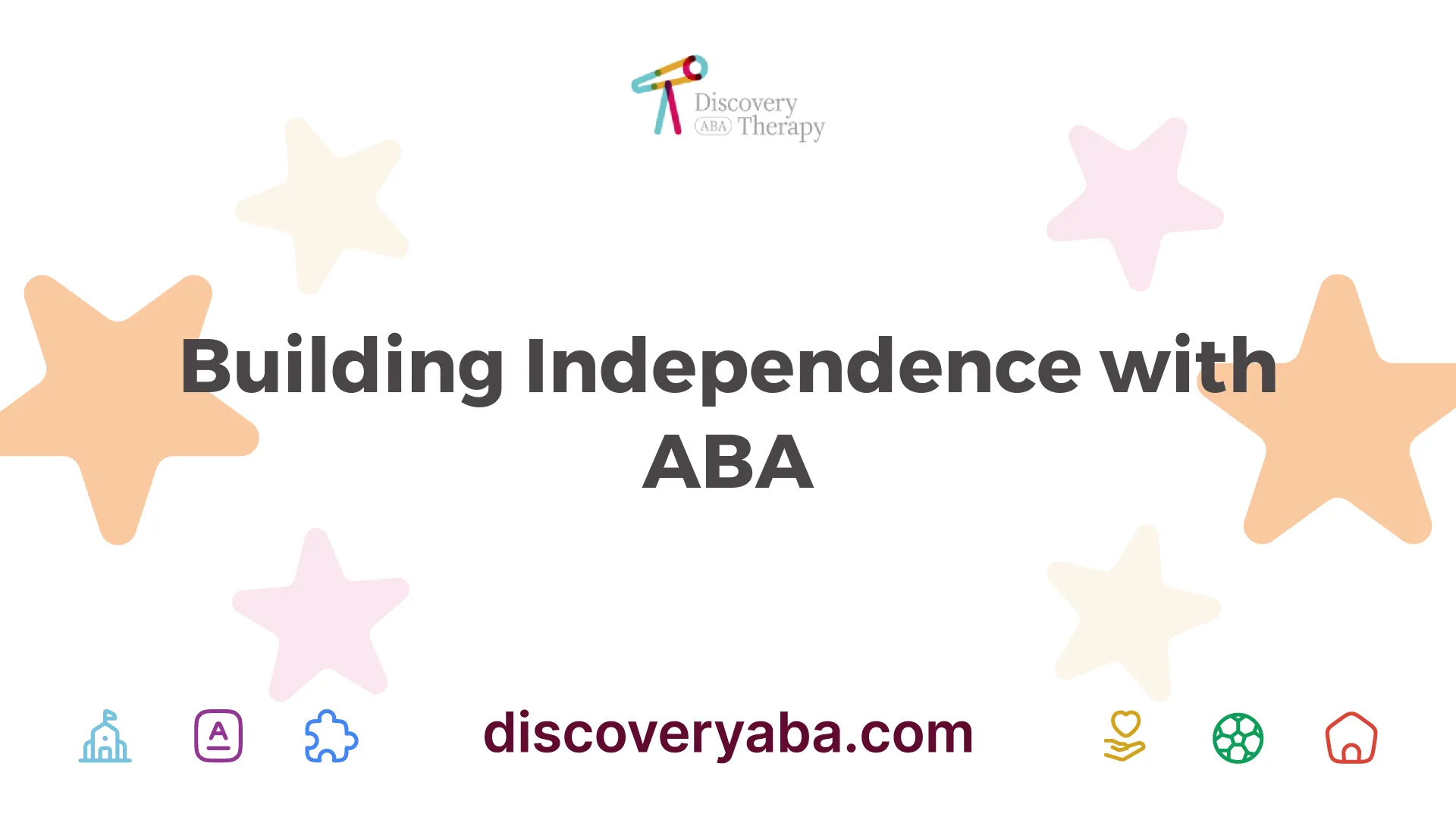Building Independence with ABA
Discover how building independence with ABA therapy empowers individuals with autism to thrive in everyday life.

Building Independence with ABA Therapy
Understanding ABA Therapy
Applied Behavior Analysis (ABA) therapy is an effective method for teaching individuals with autism essential skills for independence. It is highly individualized, with interventions tailored to meet the specific needs of each person. The therapy involves breaking down complex skills or behaviors into smaller, manageable steps. Systematic teaching of each step aims to make the desired behavior occur naturally and independently over time [1].

ABA therapy begins by assessing an individual's current level of independence. From this assessment, specific goals are set to help the individual progress toward age-appropriate milestones. Programs are customized, recognizing that what works for one person may not be effective for another. This personalized approach is key to building independence.
Key Features of ABA TherapyTailored interventionsSkills broken down into small stepsProgress monitoring through data collectionIndividualized success strategies
Addressing Challenging Behaviors
In conjunction with fostering independence, ABA therapy effectively addresses challenging behaviors that may hinder progress. Behavior analysts implement strategies that are specifically designed to manage disruptive behaviors by identifying triggers and developing appropriate responses.
For instance, ABA therapy can help in managing tantrums, obsessive behaviors, and social avoidance. By focusing on these challenging behaviors, caregivers can create a more conducive environment for learning and development. Effective techniques such as positive reinforcement, modeling appropriate behaviors, and creating structured routines contribute to gaining control over these behaviors—ultimately promoting success in daily life.
ABA programs also emphasize teaching skills to manage transitions effectively, reducing anxiety during changes in routine [4]. This holistic approach not only targets specific behaviors but also equips individuals with the tools needed to thrive in daily activities, paving the way for a more independent life. For further information on addressing specific behaviors, check our resources on managing tantrums with aba and aba for obsessive behaviors.

ABA Interventions for Independence
ABA (Applied Behavior Analysis) therapy provides various interventions tailored to support individuals with autism in achieving independence, particularly in academic and vocational settings.
Academic and Vocational Support
ABA interventions extend to educational environments, assisting individuals in developing the necessary skills for success in their studies and eventual job placements. By breaking down tasks and offering targeted instruction, ABA promotes independence in learning, ensuring that individuals can effectively engage in their educational journey [5].
Skill AreaABA FocusAcademic AbilitiesDeveloping study habits, focusSocial InteractionsPromoting teamwork and communicationVocational ReadinessJob-related skills training
ABA therapy also plays a crucial role in providing structure and consistency, which are essential for learning and generalizing skills. This method not only prepares individuals for school transitions but also for entering the workforce.
Success Stories in ABA
Success stories provide insight into the effectiveness of ABA therapy in fostering independence among individuals with autism. Numerous families have observed significant improvements in their loved ones' abilities to manage daily tasks through tailored ABA interventions.
For example:
These stories underline how ABA therapy can address various skills, such as self-care, communication, and vocational readiness, enabling individuals to lead more fulfilling, independent lives. For insight on improving peer interactions, visit improving peer interactions with aba.
Generalizing Skills with ABA
Generalizing skills learned through ABA therapy enables individuals to apply those skills across various environments. This process is essential for building independence in individuals with autism, as it ensures that skills are not only learned but are also utilized in everyday situations.
Applying Skills in Everyday Life
A significant goal of building independence with ABA therapy is to generalize learned skills to different contexts. Activities like grocery shopping, attending social events, or participating in school activities can be daunting for individuals with autism. By practicing skills in a structured environment, therapists can help individuals transfer these skills into real-life situations, leading to greater autonomy.
Some techniques to enhance skill application in daily life include:
Fostering Socially Important Behaviors
ABA therapy aims to establish and enhance socially significant behaviors, focusing on academic, social, communication, and daily living skills. According to the VCU Autism Center, these improvements enhance the quality of life for individuals with autism and foster independence.
Key socially important behaviors that ABA typically addresses include:
Behavior TypeExamplesAcademic SkillsCompleting homework, participating in class activitiesSocial SkillsMaking eye contact, engaging in conversation, and understanding social cuesCommunication SkillsExpressing needs, using appropriate language in different contextsDaily Living SkillsManaging personal care, food preparation, and understanding safety
Skill development through ABA not only benefits the individual's independence but also encourages positive interactions with peers and family, which can be reinforced using various strategies like improving peer interactions with ABA and addressing echolalia with ABA.
By focusing on generalization and fostering important behaviors, ABA can significantly contribute to the independence and overall well-being of individuals with autism.
ABA Techniques and Principles
Applied Behavior Analysis (ABA) involves the systematic application of interventions based on data analysis to improve desired behaviors and reduce problematic ones. Understanding the environmental impact on behavior and effective data usage are foundational principles in ABA therapy.
Environmental Impact on Behavior
The environment plays a critical role in shaping behavior. Environmental variables such as antecedents and consequences significantly influence learning and behavior outcomes. Antecedents are events or situations that occur before a behavior, while consequences follow the behavior and can either reinforce or discourage it. By manipulating these factors, therapists can create supportive environments that foster learning and promote positive behavioral changes.
Environmental FactorDescriptionAntecedentsTriggers or cues that lead to a behaviorConsequencesOutcomes that follow a behavior, influencing its future occurrence
Identifying specific antecedents that lead to challenging behaviors helps parents and caregivers employ effective strategies for modification. Similarly, understanding the positive consequences that can reinforce helpful behaviors is essential for promoting independence.
Using Data for Positive Outcomes
Data collection is another cornerstone of ABA therapy. It allows therapists to observe, record, and measure behavior effectively. Using various methods like direct observation, checklists, and rating scales, data collected can inform treatment strategies tailored to the individual's needs [1].
Data-driven decisions are essential for modifying individual behavior intervention plans, ensuring continuous progress toward desired outcomes.
Data Collection MethodPurposeDirect ObservationCaptures real-time behavior and environment interactionsChecklistsProvides systematic tracking of specific behaviorsRating ScalesMeasures progress over time with numerical benchmarks
The use of positive and negative reinforcement within the ABA framework promotes desired behaviors by adding or removing stimuli based on the individual's responses [1]. For instance, a child who completes a task may receive praise (positive reinforcement), while the removal of a non-preferred activity can encourage task completion (negative reinforcement).
By effectively applying these techniques and principles, parents and caregivers can play a critical role in building independence with ABA for their children, creating environments that encourage growth and learning.
Life Skills Development in ABA
ABA therapy plays a vital role in helping individuals with autism develop essential life skills. Through structured interventions, it fosters independence, allowing individuals to thrive in their daily lives.
Targeted Life Skills
ABA therapy can effectively target various life skills necessary for building independence. Some of these critical skills include:
Life SkillDescriptionSelf-CareSkills related to hygiene, grooming, and dressing.CommunicationEnhancing verbal and non-verbal interaction abilities.Social InteractionsBuilding skills for engaging appropriately with peers.Academic AbilitiesSupporting learning strategies and study habits.Vocational ReadinessPreparing for the workforce and essential job skills.
These targeted skills are broken down into manageable steps, ensuring each individual can understand and master them at their own pace. The individualized approach of ABA therapy for daily routines in autism ensures that the specific needs and goals of individuals are met, helping them move toward independence.
Tailored Interventions for Independence
The interventions within ABA are highly customized to fit the unique challenges and objectives faced by each individual. This customization might include:
The goal of these tailored interventions is to help individuals achieve greater autonomy and confidence in their daily lives, ultimately enhancing their overall quality of life (Strive ABA Consultants). By focusing on fostering independence, families can witness their loved ones navigate adulthood more effectively and develop essential emotional and social skills necessary for success.
For further support in specific areas, parents can explore resources on reducing anxiety through ABA, managing tantrums with ABA, and addressing echolalia with ABA. These approaches ensure a comprehensive strategy towards building independence and enhancing life skills.
Effective ABA Teaching Methods
Applied Behavior Analysis (ABA) therapy encompasses a variety of teaching methods designed to promote learning and independence in individuals with autism. Two prominent techniques within ABA are Discrete Trial Training (DTT) and the use of positive and negative reinforcement.
Discrete Trial Training (DTT)
Discrete Trial Training (DTT) is a highly structured and intensive teaching method that breaks down complex skills into smaller, more manageable components. This approach is typically used to teach new skills such as language, social, and academic skills, following a specific order of steps until mastery is achieved.
Here is a simplified breakdown of the DTT process:
StepDescription1. Discriminative StimulusPresent a clear instruction or question.2. ResponseThe individual responds to the instruction.3. ConsequenceProvide feedback based on the response.4. Data CollectionRecord the response for assessment and future planning.
This systematic approach helps individuals gain confidence as they master skills sequentially, contributing to the overarching goal of building independence with ABA.
Positive & Negative Reinforcement
Reinforcement is a fundamental strategy in ABA that encourages desired behaviors through rewarding outcomes or the removal of unpleasant elements. Positive reinforcement involves adding something to the environment that is valued, which increases the likelihood of the desired behavior being repeated. Conversely, negative reinforcement involves removing something aversive to promote the desired behavior.
Examples of reinforcement methods:
Type of ReinforcementDescriptionExamplePositive ReinforcementAdding a reward after a desired behaviorGiving praise or a sticker after a child raises their hand in class.Negative ReinforcementRemoving an unpleasant condition after a desired behaviorAllowing a child to leave the table after completing their meal without fussing.
Over time, the consistent application of these reinforcement techniques can lead to positive behavior changes and greater levels of independence. Positive reinforcement is one of the main strategies used in ABA therapy, as it enhances the likelihood of behaviors being repeated.
By integrating methods like DTT and various forms of reinforcement, ABA effectively supports individuals in acquiring necessary life skills and addressing behavioral challenges, ultimately fostering independence and overall success. For additional techniques, explore our links on aba therapy for attention issues or addressing echolalia with aba.
References
[2]:
[3]:
[4]:
[5]:
[6]:
[7]:
[8]:
Does Your Child Have An Autism Diagnosis?
Learn More About How ABA Therapy Can Help
Find More Articles
Contact us
North Carolina, Nevada, Utah, Virginia
New Hampshire, Maine
Arizona, Colorado, Georgia, New Mexico, Oklahoma, Texas
.avif)




































































































